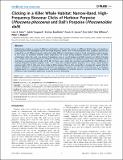Files in this item
Clicking in a killer whale habitat : narrow-band, high-frequency biosonar clicks of harbour porpoise (Phocoena phocoena) and Dall's porpoise (Phocoenoides dalli)
Item metadata
| dc.contributor.author | Kyhn, Line A. | |
| dc.contributor.author | Tougaard, Jakob | |
| dc.contributor.author | Beedholm, Kristian | |
| dc.contributor.author | Jensen, Frants H. | |
| dc.contributor.author | Ashe, Erin | |
| dc.contributor.author | Madsen, Peter T. | |
| dc.contributor.author | Williams, Robert | |
| dc.date.accessioned | 2014-07-16T14:31:02Z | |
| dc.date.available | 2014-07-16T14:31:02Z | |
| dc.date.issued | 2013-05-28 | |
| dc.identifier | 131396460 | |
| dc.identifier | cffd4a1c-25bd-4192-a71b-36f2e6da7ab7 | |
| dc.identifier | 000319733000020 | |
| dc.identifier | 84878414871 | |
| dc.identifier.citation | Kyhn , L A , Tougaard , J , Beedholm , K , Jensen , F H , Ashe , E , Madsen , P T & Williams , R 2013 , ' Clicking in a killer whale habitat : narrow-band, high-frequency biosonar clicks of harbour porpoise (Phocoena phocoena) and Dall's porpoise (Phocoenoides dalli) ' , PLoS One , vol. 8 , no. 5 , e63763 . https://doi.org/10.1371/journal.pone.0063763 | en |
| dc.identifier.issn | 1932-6203 | |
| dc.identifier.uri | https://hdl.handle.net/10023/5027 | |
| dc.description | This study was funded by the Aarhus University Research Foundation, the Danish Ministry of Environment (Jagttegnsmidlerne) and by frame grants to PTM from the National Danish Science Research Council. RW was supported by a Marie Curie International Incoming Fellowship within the 7th European Community Framework Programme, and FHJ by a postdoctoral fellowship from the Danish Council for Independent Research | Natural Sciences. | en |
| dc.description.abstract | Odontocetes produce a range of different echolocation clicks but four groups in different families have converged on producing the same stereotyped narrow band high frequency (NBHF) click. In microchiropteran bats, sympatric species have evolved the use of different acoustic niches and subtly different echolocation signals to avoid competition among species. In this study, we examined whether similar adaptations are at play among sympatric porpoise species that use NBHF echolocation clicks. We used a six-element hydrophone array to record harbour and Dall's porpoises in British Columbia (BC), Canada, and harbour porpoises in Denmark. The click source properties of all porpoise groups were remarkably similar and had an average directivity index of 25 dB. Yet there was a small, but consistent and significant 4 kHz difference in centroid frequency between sympatric Dall's (137 +/- 3 kHz) and Canadian harbour porpoises (141 +/- 2 kHz). Danish harbour porpoise clicks (136 +/- 3 kHz) were more similar to Dall's porpoise than to their conspecifics in Canada. We suggest that the spectral differences in echolocation clicks between the sympatric porpoises are consistent with evolution of a prezygotic isolating barrier (i.e., character displacement) to avoid hybridization of sympatric species. In practical terms, these spectral differences have immediate application to passive acoustic monitoring. | |
| dc.format.extent | 12 | |
| dc.format.extent | 1142306 | |
| dc.language.iso | eng | |
| dc.relation.ispartof | PLoS One | en |
| dc.subject | Transmission beam pattern | en |
| dc.subject | Echolocation signals | en |
| dc.subject | Neophocaena-phocaenoides | en |
| dc.subject | Orcinus-orca | en |
| dc.subject | Pseudorca-crassidens | en |
| dc.subject | British-columbia | en |
| dc.subject | Tonal signals | en |
| dc.subject | Dolphins | en |
| dc.subject | kHz | en |
| dc.subject | Sonar | en |
| dc.subject | QL Zoology | en |
| dc.subject.lcc | QL | en |
| dc.title | Clicking in a killer whale habitat : narrow-band, high-frequency biosonar clicks of harbour porpoise (Phocoena phocoena) and Dall's porpoise (Phocoenoides dalli) | en |
| dc.type | Journal article | en |
| dc.contributor.institution | University of St Andrews. School of Biology | en |
| dc.identifier.doi | 10.1371/journal.pone.0063763 | |
| dc.description.status | Peer reviewed | en |
This item appears in the following Collection(s)
Items in the St Andrews Research Repository are protected by copyright, with all rights reserved, unless otherwise indicated.

